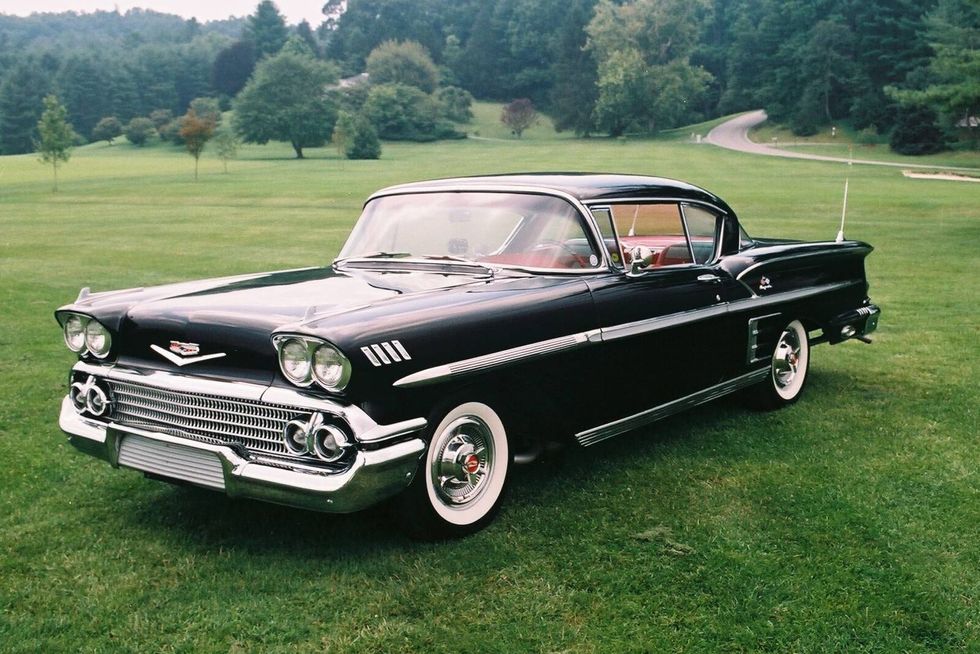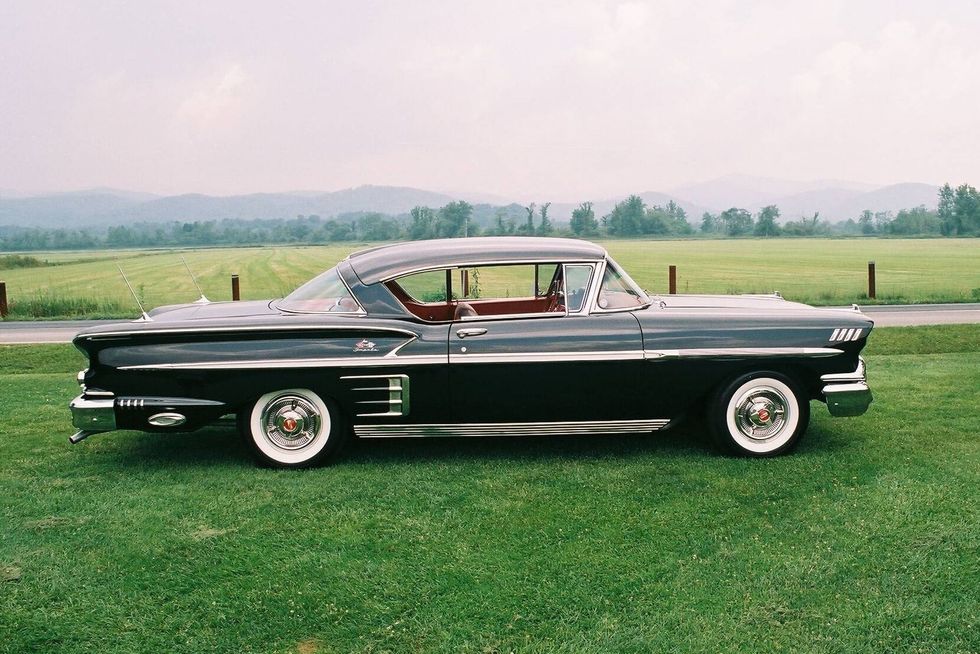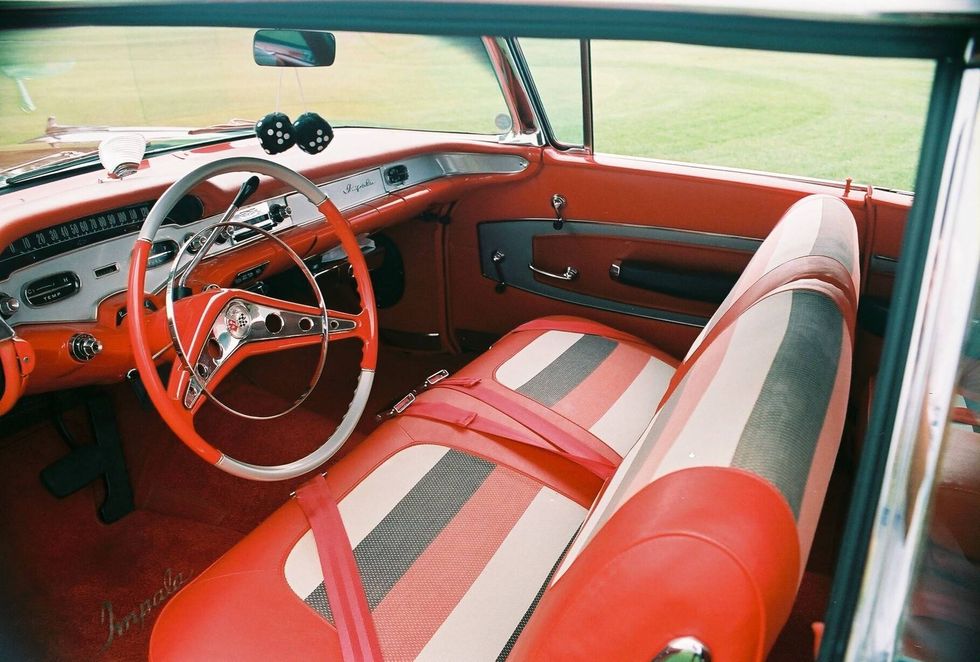Buy
Resources
Entertainment
Magazine
Community
Photo via Nash Car Club.
It didn't take long after we posted the photos of the prototype 1946 Nash pickup that we got the entire scoop on the pickup's history, how it was built, and where it is today. To begin with, Thomas Harrington, who now owns the pickup, left the following comments:
The serial number, K77646 is a Nash 600 number, a few numbers before the first Nash 600 car for the year 1946. The cab ID plate says "SAMPLE". I have the original plate from perfection Steel Body company, Galion, Ohio, which did the box; model number P1, serial number 80072. A replica of the plate is on the truck. A couple of years later a few pickups were made at the same time the larger trucks were made for dealers and export. Don Loper of NCCA found the truck.I should add that I probably erred in restoring the truck, by making it fancier than it no doubt was originally. As no early engine was with the car a 1941 Ambassador Twin ignition 6 with overdrive was added. A wood floor to the box was added and a storage box in wood (removable). The word NASH was added to the rear gate using the same form as the original Nash lettering from the truck, which I keep separate from the truck.
We then heard from Don Loper:
I can tell you about the truck as I was told when I bought it. It's titled as a 1946 Nash pickup, but it was built at Nash Engineering in Kenosha during WWII, with an eye toward building trucks after the war. Then after the war, they couldn't get the steel to build all the cars they could sell, so the project went no further.The man who more or less designed the truck took it with him when he retired in the '50s and traded it in on a car at Waters Rambler (long closed) in Madison, WI. Waters used the truck for years as a car pusher, parts chaser, runs to the dump, etc, and when they closed up in the '60s, one of their mechanics bought it for use on his farm. Later, one of the mechanic's sons took it apart and it sat in a tobacco shed till I found it about 1980.
When I first heard of it, my first thought was someone cut a car off and made it, and I was right except that the someone was Nash Motors. The cab is a 42 Nash 600 4-dr, cut off right behind the B pillar (still visible) and a new rear panel welded in. I know it's a 42 as the holes for the air filters on the ill-fated Lancia-type front suspension are in the inner panels under the hood. The resulting cab is mounted on a 1936 Nash frame which had a heavy X-member with 41 Ambassador rear springs and axle and front leaf springs from about 1936 with a beam axle from 1939. It had an open drive shaft. Airplane type shocks on the front but there was no provision for rear shocks.
The pickup box was bought from the Perfection Steel Body Company of Gallion, OH, and 41 Ambassador rear fenders were fitted along with fillets to move them out from the box. As you noted, it is shown with a side mounted spare (still has it) and without.
The interior was lined with a heavy cardboard like others of the period and the seat was covered in heavy "leatherette". The dash was standard Nash car, even including the engine turned aluminum around the gauges. The only change was it had no clock and there was no provision for one as the glove compartment door had no hole in it (like the inexpensive 600 business coupe).
The pictures you have in the blog are all of the same truck except for the 48 Ambassador pickup. What they did was to put a front end on it, take it out and take pictures, bring it back and change it and take more pictures. I'm sure of this as when I got the truck, all of the holes for the different grilles, etc, were still in the front sheetmetal. I found that the company pictures for the most part were taken at the Southport Beach House in Kenosha.
I heard that there were several 48 Ambassador pickups built for use at the plant and the proving ground out by Burlington, WI. We do have one of them in the Nash Club.
As for where it is today, Thomas has loaned it to the Wisconsin Automotive Museum in Hartford, Wisconsin.
Recent
Buyer's Guides
RPO Z06 Makes the New-For-’63 Chevrolet Corvette Sting Ray Race Ready and Extremely Valuable
Photo: GM Media Archives
Due to changing external forces, General Motors had a fickle relationship with factory-backed racing in the 1950s and 1960s, and the corporation was ostensibly keeping motorsports at arm’s length when the second-generation Corvette was nearing its debut. This didn’t stop the engineers behind Chevrolet’s sports car from designing and building the specialty parts the new Sting Ray would need to establish dominance in competition. The Regular Production Option code Z06 was selected for 199 coupes, and surviving examples of that limited production run are considered the most coveted and valuable road-legal 1963 Corvettes in existence.
Regardless of what the official GM policy on racing was at the time, the Corvette team had long been actively encouraging motorsports and the glory that brought to this model and Chevrolet as a whole. Privateers who wanted to compete in their 1962 roadsters could specify RPO 687 to gain heavy-duty suspension and braking components, as well as a quicker steering ratio and 37-gallon fuel tank; ticking the RPO 582 box brought a 360-horsepower 327-cu.in. V-8 topped with Rochester mechanical fuel injection. Versions of these special upgrades would have a place in the new-for-’63 Sting Ray as well, for a time similarly bundled under RPO Z06, a.k.a. “Special Performance Equipment.”
Selecting this, a racing hopeful had to lay out a not-insubstantial $1,818.45 ($18,110 in today’s money) atop the $4,038 (circa $40,210) MSRP of a 1963 Corvette coupe that was also optioned with the L84 fuel-injected 360-hp V-8 ($430.40, or $4,285), four-speed manual transmission ($188.30, or $1,875), and Positraction limited-slip differential ($43.05, or $429). Later in the year, Chevrolet lowered the Z06 package cost to $1,293.56 ($12,880) by making the initially included cast-aluminum knock-off wheels and 36.5-gallon fuel tank —RPO P48 and N03—into standalone options. Even in its most basic form, a Z06-equipped 1963 Sting Ray was an expensive car.
And it has always been one, especially from the mid-2000s when retail book values shot up exponentially. Classic.com has been tracking the values of many variants of Chevy’s sports car for the past five years, and non-Z06-equipped 1963 models now sell at auction for an average sum just under $160,000. The Z06 variant is a special case, and although the website currently considers the ’63 Corvette Z06 to be a declining market benchmark at $510,165, it has hardly reached bargain-basement status—the current average public-sale price as of press time is $531,154. Thirteen Z06s have sold at auction since August 2019, with the least expensive being a coupe that changed hands via Mecum in Houston for $235,000 in April 2023, and the priciest being a sub-5,400-mile original that commanded $1,242,500 (the pre-sale estimate was $750,000-$900,000) at Gooding & Company’s Amelia Island event in March 2022. These figures handily outstrip current retail book values that range between $219,000 and $447,500.
Value Trend - 1963 Chevrolet Corvette RPO Z06

Keep reading...Show Less
For 1958, all-new styling at every General Motors passenger-car division ushered in big changes, just as the corporation was celebrating its 50th anniversary. It was also the final year with Harley Earl at the helm of GM design. Though the new models were longer and lower in proportion than in previous years, Earl’s signature use of excessive chrome remained unabated. That brightwork continued a trend that had dominated automotive design throughout the Fifties. For 1958, it worked seamlessly with those new designs that presented a broad departure from previous years.
Currently listed on Hemmings Auctions are a pair of faithfully restored hardtop coupes from the GM catalog from that momentous year. With wide chrome grilles surrounding four headlamps and copious brightwork including side trim the length of the body, this 1958 Chevrolet Impala Sport Coupe and 1958 Pontiac Bonneville Sport Coupe both handsomely display the heavily Earl-influenced styling that made headlines for GM.

1958 Pontiac Bonneville Sport Coupe
While GM made general announcements and events around its 50th anniversary for 1958, only Pontiac incorporated the occasion into its advertising. It mattered little that the first Pontiac rolled off the assembly line in 1926 as sub-brand of Oakland. Laid out in large letters in its brochure, Pontiac’s advertising theme for 1958 carried the tagline “The boldest advance in fifty years,” also declaring “A new kind of cars is born!” Previously introduced as a well-optioned convertible version of the Star Chief in 1957, the standalone Bonneville arrived for 1958.
Promising “the first true union of sport car action with town car luxury,” the Bonneville was only produced as a pillarless hardtop Sport Coupe or a drop-top Sport Convertible for 1958. As “a modern ultimate for the man who loves cars…this steel-muscled road machine,” the Bonneville featured a 370-cu.in. V8 engine with a four-barrel carburetor and 10:1 compression as standard equipment. An optional Tri-Power setup with triple two-barrel carburetors was given the “Tempest 395” moniker for its 395 lb-ft torque rating.

As the late 1950s was peak Jet Age, aeronautical and rocket themes pervade the details of the Bonneville. The leading edge of the scalloped rear quarter panels featured a very rocket-like piece of chrome trim that extended to a point at the front of the car. On top of each front fender, just before the headlamps, sat additional chrome-plated pieces that resembled delta-wing jets with appendages that lead into creases atop the fenders like contrails from jet engines.
Finished in Burma Green with Calypso Green accents, this 1958 Bonneville Sport Coupe, one of 9,144 produced, appears to have been restored some years ago, with a fit and finish that looks to be holding up. It is equipped with the Tri-Power 370 and a four-speed Super Hydra-Matic transmission. It is additionally fitted with power windows and power brakes, along with the rare Trans-Portable radio unit that can be removed and used as a portable radio with its built-in speaker and ability to run off batteries. The seller notes no problems with the drivetrain and asserts that the transmission shifts well.

1958 Chevrolet Impala Sport Coupe

Chevrolet didn’t revel in the golden jubilee news that Pontiac touted, but its advertising in 1958 suggested that its redesigned models were “Almost too new to be true!” The ad copy also promised that “You’ll like being looked at in your beautiful ’58 Chevrolet.” Longer, lower and wider than the famous “Tri-Five” models that preceded it, the Chevrolet models somewhat mirrored what was going on at Pontiac, but with a rear-end treatment that seemed to show the previous year’s tall tailfins flopped over somewhat. In magazines ads, the words accompanying the first-year Impala Sport Coupe suggested “This sleek styles-setter promises action, gaiety, glamor—and it keeps its promises beautifully.”
Like the Bonneville nameplate, the first Chevrolet to wear the Impala badge arrived in 1958. Chevy also introduced its first big-block V8, the so-called “W” engine. For 1958, Chevrolet dubbed this 348-cu.in. engine the Turbo-Thrust V8 when equipped with a four-barrel carburetor and Super Turbo-Thrust when fitted with Tri-Power triple carburetion. Though it lacked the aviation/space themes of the Bonneville’s styling, the similarly proportioned Impala was also festooned with plenty of brightwork, from the wide grille to side spears that ran nearly from the taillights to the headlamps. Pound-for-pound, the massive wraparound bumpers probably contained the highest amount of chrome on the car.

Finished in Onyx Black with a bold Rio Red-dominated interior, this 1958 Chevrolet Impala Sport Coupe now on Hemmings Auctions features a long-term restoration that spanned the 1990s. Completed in 2001, it appears to be holding up well. The photos of the very clean undercarriage that accompany the listing tell a story that the car has been taken care since that redo. This example is fitted with the four-barrel 348 that was rated at 250 horsepower when new. Power reaches the rear axle via a two-speed Powerglide automatic transmission.
GM made some distinct design changes for 1958. With plenty of models across five passenger-car divisions, we are fortunate to have options in the collector car hobby when it comes to these chrome-laden machines. Which of these ’58 hardtop coupes would you like to cruise in?
Head on over to Hemmings Auctions to take a look and let us know.
Keep reading...Show Less






